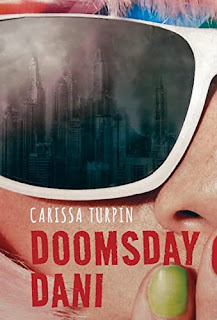Let’s (Not) Panic Like It’s 1999: How Doomsday Dani Came to Be - Carissa Turpin
In many ways, the protagonist of my middle grade novel, Dani Collier, is a normal tween girl. She attends middle school, which she finds dull and unimportant. She likes to draw, play video games, and bicker with her little sister. There’s one characteristic, however, that sets her apart: it’s 1999, and Dani is a doomsday prepper obsessed with the forecasted Y2K disaster.
Like most ideas that germinate in my
brain, Dani was inspired by my students. In 2019, I was working as a language
arts teacher at McKemy Academy of International Studies in Tempe, Arizona. It
was the final day of school before holiday break, the bell signaling dismissal
had already chimed, and a few students were lingering in my classroom and
saying their goodbyes.
“It’s going to be so weird seeing
the last two digits of the calendar change,” one student said to another.
“Can you imagine what it was like
going from 1999 to 2000?” the second student remarked.
Like most elder millennials, I can
remember where I was on New Year’s Eve 1999 with surprising clarity, so I
couldn’t help piping up.
“We
thought the world was going to end,” I said.
When they turned to me wearing
baffled expressions, I hurried to clarify. I stumbled through an explanation
about computer glitches and a song by The Artist Formerly Known as Prince, but
it was clear this was their first time hearing about Y2K. In their world,
technology was infallible. Every device in their life—from their smartwatches
to their cell phones to the electronic assistants like Alexa that sat in their
kitchens—updated automatically and flawlessly. It was difficult for them to
imagine a world where this wasn’t the case. As for me, I noted that this was a
period in history that middle schoolers knew little about and thought it would
make for a good book. I jotted the idea down at home and quickly forgot about
it.
Then, in March of 2020, the world
turned upside down.
I can remember my inbox filling with
panicked emails from students—they can’t shut down school, can they? I
was the adult tasked with reassuring them, but, in truth, between refreshing
the homepage of the CDC and wiping down my groceries with a Clorox wipe, I was
looking for an adult to reassure me.
It was then that I turned to writing, determined to
flesh out my idea of a middle grade novel with a Y2K setting. There was
something so comforting about being the author, about knowing that my
protagonist would ultimately make it past all her worries unscathed. It gave me
hope that my students and I could weather this storm, too.
Since the moment I finished writing
it, I’ve believed that Doomsday Dani is a book that adults and kids can
read together. While adults can bask in the Y2K nostalgia, kids and adults
can learn some important lessons: the importance of verifying online sources
and how to cope with hardships like bullying and divorce. I believe, too, that
readers will finish the novel feeling a certain degree of hope. Like Dani, we
are tough enough to endure uncertain times and we can look forward to better
days ahead.
~
Be sure to keep up with Carissa at her author site, and pre-order a copy of Doomsday Dani here.


Comments
Post a Comment